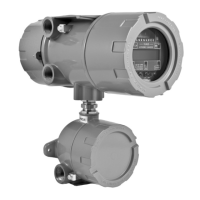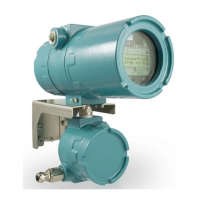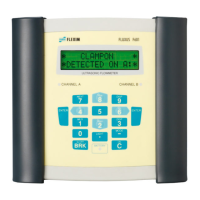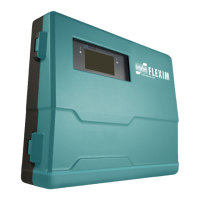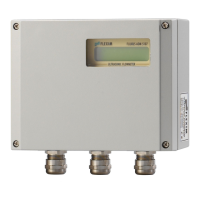Do you have a question about the Flexim FLUXUS F808 F1 Series and is the answer not in the manual?
| Measurement Range | Depends on pipe size and fluid |
|---|---|
| Flow Velocity Range | 0.01 to 25 m/s |
| Outputs | 4-20 mA, pulse, frequency, relay |
| Enclosure | Aluminum or stainless steel |
| Display | LCD with backlight |
| Measurement Principle | Transit time difference |
| Fluid Types | Liquids |
| Pipe Size Range | 6 to 6500 mm |
| Operating Temperature (Transmitter) | -20°C to +60°C |
| Temperature Range | -40 to +200 °C (depending on sensor type) |
| Operating Temperature (Transducers) | -40 to +200 °C |
| Power Supply | 24 V DC, 100-240 V AC |
| Communication Interfaces | RS485, Modbus, Ethernet |
| Protection Class | IP66 |
| Certifications | ATEX, IECEx |
Crucial safety information and warnings for operating the ultrasonic flowmeter.
Essential precautions for handling the precision instrument to ensure accurate measurements and prevent damage.
Explanation of TransitTime and NoiseTrek measurement principles for flow velocity determination.
Guidelines for selecting the transmitter's location considering measuring point and ambient temperature.
Steps for physically installing the transmitter, including wall and pipe mounting methods.
Connecting transducer cables to the F808**-A1 transmitter, including cable gland procedures.
Connecting transducer cables to the F808**-F1 transmitter, detailing conduit and terminal connections.
Connecting transducer cables to the F808**-F2 transmitter, covering various cable types and SMB adapters.
Connecting the power supply cable to the transmitter, emphasizing equipotential bonding and safety switch requirements.
Instructions for connecting the RS232 serial interface for data transmission.
Instructions for connecting the RS485 serial interface for data transmission.
Guidelines for selecting the transmitter's location for FLUXUS F809, considering ambient conditions.
Overview of transmitter connection points for power, outputs, and transducers on FLUXUS F809.
Connecting transducer cables to the F809**-A1 transmitter, including cable gland and terminal assignments.
Connecting transducer cables to the F809**-F1 transmitter, covering conduit and terminal connections.
Connecting the power supply to the FLUXUS F809 transmitter, including safety and equipotential bonding.
Explanation of transmitter outputs, including current loops and pulse outputs for FLUXUS F809.
Connecting the RS232 serial interface for data transmission on FLUXUS F809.
Connecting the RS485 serial interface for data transmission on FLUXUS F809.
Preparing the pipe surface by cleaning and sanding for optimal transducer mounting.
Correctly orienting transducers and setting the distance between them for accurate measurements.
Detailed steps for installing the Variofix L mounting fixture on the pipe for reflection or diagonal arrangements.
Instructions for installing the Variofix C transducer mounting fixture, including disassembly and rail installation.
Guide for installing the PermaFiX fixture, emphasizing use in hazardous locations and bolt/strap mounting.
Configuring essential parameters like language, units, time, and date upon first startup.
Entering essential pipe parameters: diameter, circumference, wall thickness, material, and lining.
Activating or deactivating measuring and calculation channels for the measurement process.
Recommending and fine-tuning the transducer distance for optimal signal reception.
Verifying measurement consistency by comparing transducer distance with sound speed data.
Configuring the displayed physical quantity and its unit of measurement.
Customizing the display to show one or two measured values simultaneously.
Displaying optimum and entered transducer distances, with internal deviation compensation.
Configuring the damping factor to average measured values and adapt to flow dynamics.
Calculating and displaying total volume or mass, with separate totalizers for flow directions.
Utilizing NoiseTrek parallel beam for improved signal quality in challenging fluid conditions.
Configuring HybridTrek mode for automatic switching between TransitTime and NoiseTrek based on fluid conditions.
Enabling and using FastFood mode for accurate measurement of highly dynamic fluid flows.
Defining calculation functions and parameters for calculation channels using selected measuring channels.
Managing the data logger: activation, capacity, and types of stored data.
Real-time transmission of measurement data to a terminal program.
Methods for transmitting logged data to a PC via serial interface or specialized software.
Using the FLEXIM FluxData software for offline data transfer from the logger.
Configuring how transducer distance is displayed based on user or auto selection.
Setting units for length, temperature, pressure, density, viscosity, and sound speed.
Configuring core measurement parameters including sound speed comparison, velocity display, cut-off flow, and turbulence mode.
Enabling and disabling SuperUser mode for advanced analysis and parameter adjustments.
Configuring flow parameters such as profile bounds and velocity correction for specific measurement scenarios.
Applying a correction formula to measured flow velocity for improved accuracy.
Installing outputs by assigning channels, physical quantities, and signal properties.
Activating analog outputs after installation and setting their measuring ranges.
Configuring frequency outputs to function as pulse outputs for totalizing fluid volume or mass.
Configuring binary outputs to emit pulses based on accumulated fluid volume or mass.
Diagnosing and resolving issues preventing measurement or causing incorrect readings.
Measurement configuration settings including WaveInjector, NoiseTrek, velocity limits, and cut-off flow.
